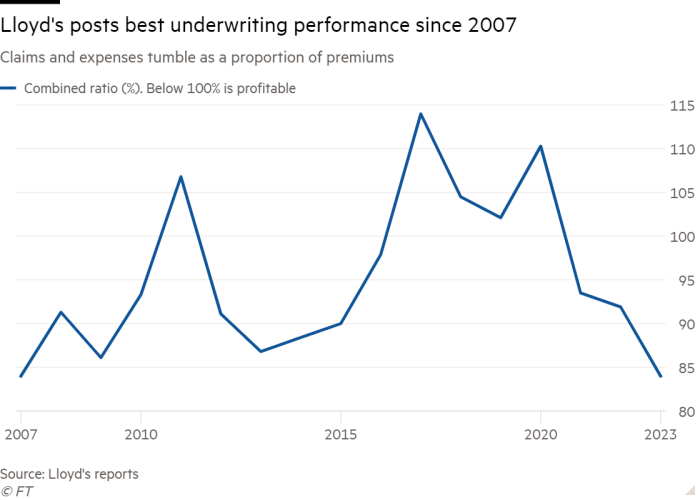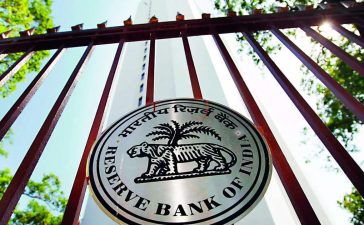Unlock the Editor’s Digest for free
Roula Khalaf, Editor of the FT, selects her favourite stories in this weekly newsletter.
Lloyd’s of London has delivered its best underwriting performance since 2007 and signalled that commercial insurance prices are likely to stay high in the coming years.
The institution, a marketplace where more than 50 insurers and reinsurers agree to underwrite risks for businesses, reported a combined ratio — a closely tracked measure of claims and expenses as a proportion of premiums — of 84 per cent last year.
That was up almost 8 percentage points on 2022, and was well under the 100 per cent level that separates an underwriting profit from a loss. The performance was helped by a quiet year for hurricane claims as well as a rapid run-up in reinsurance prices over the past 18 months.
“Some insurers were quite heavily hit by large losses, which speaks for our risk-taking,” said Lloyd’s chief financial officer Burkhard Keese. “We were not involved that much in the Turkey earthquake, we stayed clear of the convective storms in the US, we had no exposure to the wildfires in Hawaii, we had no exposure to the hurricane in Acapulco.”
Keese said he expected the cost of insurance to “level out” over the next four to five years rather than fall, arguing that reinsurers had failed to earn their cost of capital in recent years.
“I wouldn’t call it top of the cycle, it is now where it needs to be for the next four or five years [to satisfy investors],” he added.
According to an index from insurance broker Marsh, global commercial insurance rates rose in the final three months of last year, the 25th straight quarter of increases.
Lloyd’s benefited as a mixture of the Ukraine war, inflation and climate risks sparked a significant repricing of reinsurance contracts.
Lloyd’s, which reports aggregated figures covering the insurers and reinsurers that operate in the market, said it took in premiums of £52.1bn last year, up nearly 12 per cent from 2022. Its underwriting profit reached £5.9bn, up from £2.6bn.
However, overall premiums fell shy of the £56bn revenue target set last year, which Keese said was partly a result of firms not writing as much business as anticipated in areas such as cyber and directors & officers insurance, where prices have come off.

Lloyd’s struck a deal in December to stay at its iconic One Lime Street headquarters until at least 2035, and embarked on a renovation of its trading space. Numbers coming into its headquarters have improved after slumping during the pandemic and are now at almost 80 per cent of pre-coronavirus levels. Keese said that was a “good number”, given the rise of digital trading.
Last year, the market’s chief executive John Neal said he wanted to “get Monday back”, echoing other finance executives who are trying to increase workers’ time in the office.
“I think Monday is getting better,” said Keese. “Friday is not getting better.”
The robust performance from Lloyd’s was echoed in the annual results from Beazley, one of the market’s largest insurers. The FTSE 100 group reported record pre-tax profits of $1.25bn last year and announced a $325mn share buyback.











